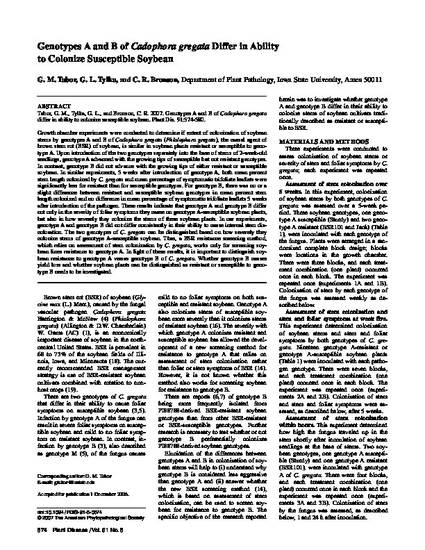
Growth chamber experiments were conducted to determine if extent of colonization of soybean stems by genotypes A and B of Cadophora gregata (Phialophora gregata), the causal agent of brown stem rot (BSR) of soybean, is similar in soybean plants resistant or susceptible to genotype A. Upon introduction of the two genotypes separately into the base of stems of 2-week-old seedlings, genotype A advanced with the growing tips of susceptible but not resistant genotypes. In contrast, genotype B did not advance with the growing tips of either resistant or susceptible soybean. In similar experiments, 5 weeks after introduction of genotype A, both mean percent stem length colonized by C. gregataand mean percentage of symptomatic trifoliate leaflets were significantly less for resistant than for susceptible genotypes. For genotype B, there was no or a slight difference between resistant and susceptible soybean genotypes in mean percent stem length colonized and no difference in mean percentage of symptomatic trifoliate leaflets 5 weeks after introduction of the pathogen. These results indicate that genotype A and genotype B differ not only in the severity of foliar symptoms they cause on genotype A-susceptible soybean plants, but also in how severely they colonize the stems of these soybean plants. In our experiments, genotype A and genotype B did not differ consistently in their ability to cause internal stem discoloration. The two genotypes of C. gregata can be distinguished based on how severely they colonize stems of genotype A-susceptible soybean. Thus, a BSR resistance screening method, which relies on assessment of stem colonization by C. gregata, works only for screening soybean lines resistance to genotype A. In light of these results, it is important to distinguish soybean resistance to genotype A versus genotype B of C. gregata. Whether genotype B causes yield loss and whether soybean plants can be distinguished as resistant or susceptible to genotype B needs to be investigated.
Available at: http://works.bepress.com/gregory-tylka/181/

This article is published as Tabor, G. M., G. L. Tylka, and C. R. Bronson. "Genotypes A and B of Cadophora gregata differ in ability to colonize susceptible soybean." Plant disease 91, no. 5 (2007): 574-580, doi: 10.1094/PDIS-91-5-0574. Posted with permission.